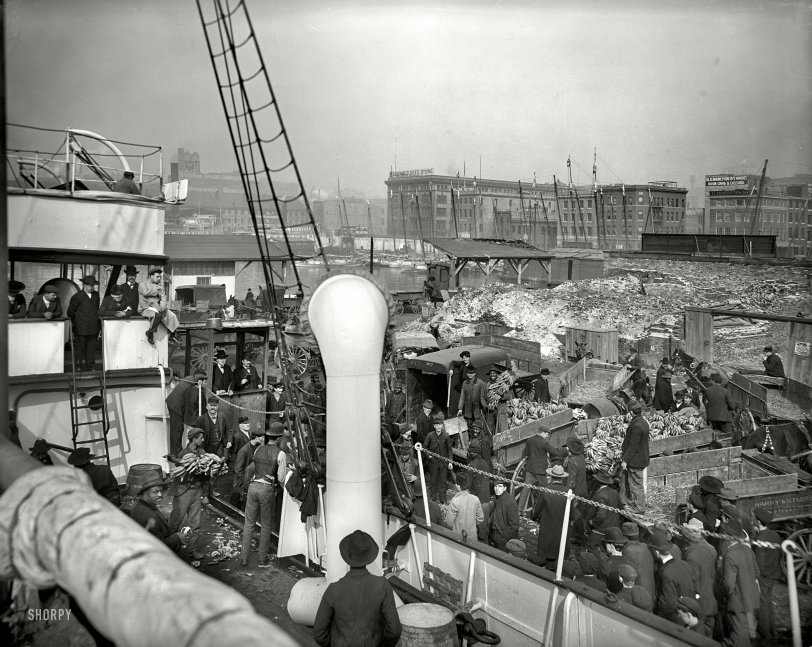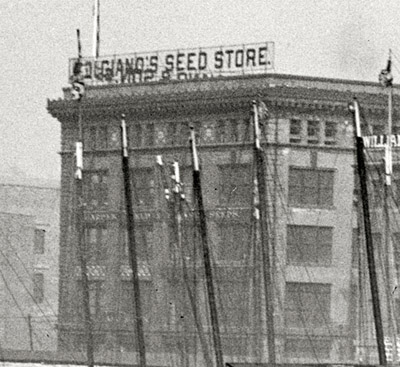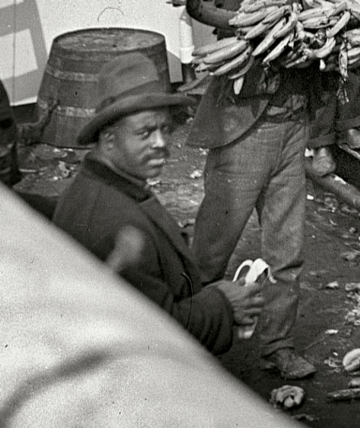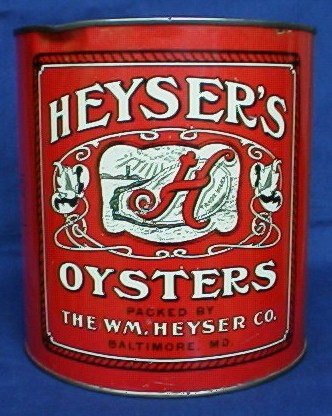


Framed or unframed, desk size to sofa size, printed by us in Arizona and Alabama since 2007. Explore now.
Shorpy is funded by you. Patreon contributors get an ad-free experience.
Learn more.

- Details, Details
- What's that building to the left of the tower?
- Coal Barges
- Bromo-Seltzer
- Inner harbor
- The Basin
- What a headache!
- Giant stepladder?
- Baldwin 62303
- Baldwin VO-1000
- Cold
- No expense spared
- Tough Guys
- Lost in Toyland
- And without gloves
- If I were a blindfolded time traveler
- Smoke Consumer Also Cooks
- Oh that stove!
- Possibly still there?
- What?!?
- $100 Reward
- Freeze Frame
- Texas Flyer wanted
- Just a Year Too Soon
- WWII -- Replacing men with women at the railroad crossing.
- Yes, Icing
- You kids drive me nuts!
- NOT An Easy Job
- I wonder
- Just add window boxes
Print Emporium
Bananas to Baltimore: 1905

Baltimore, Maryland, circa 1905. "Unloading banana steamer." A teeming scene that calls to mind the paintings of Brueghel, if Brueghel ever did bananas. Note the damage from the Great Fire of 1904. 8x10 glass negative. View full size.
Ship Name
Does anyone know the name of this ship?
Thanks
james@thebeckhams.us
Dock Smell
In response to Darnuad's comment: my childhood memories of the harbor involve the enveloping odor of SPICES. McCormick's was there, and it was the best-smelling place I've ever been.
"Hawaii" and bananas
I recall reading James Michener's "Hawaii", when the pregnant Jerusha Hale (played by Julie Andrews, in the film version) is aboard ship for the gruelling journey to Hawaii. In order to keep her strength up, she is forced to eat bananas which, by this time in the journey are nearly liquid in their black, greasy skins. She's so disgusted with them that she finally throws them overboard.
When she arrives in Hawaii, she is offered bananas and doesn't realize that the yellow fruit is the same thing...
Bolgiano's Seed Store
[stanton_square's contributions to Shorpy tend to be of the Joe Friday type: "All we want are the facts." On occasion this blogger stumbles across documents which have both 1) historically relevant facts and 2) overt racism or sexism. In such cases it is sometimes difficult to decide what is worth transcribing. The following 1903 Washington Post article contains such a passage. While I decided to transcribe this passage, I feel obligated to point out the back-handed anti-immigrant racism contained in the first paragraph. The second article, from the American Poultry Advocate, relates the disastrous business impact of the Baltimore fire of 1904 and contains an odd usage of the word 'wonderfully.']
J. Bolgiano & Son, founded 1818. Bolgiano's Seed Store was located at the corner of Pratt and Light. Several heirloom tomato varieties grown today are descended from Bolgiano stock including: Greater Baltimore, John Baer, and IXL Extremely Early.
Washington Post, May 17 1903English names are not the only ones that have been handed down from Revolutionary times, and often a name that seems to indicate foreign blood represents an old American family. This is illustrated in the firm name of F.W. Bolgiano & Co., of this city, an offspring of a firm of like name established in 1818 in Baltimore. It is Italian in origin, but no longer represents Italian stock more than English. The name is known throughout the country to purchasers of seeds, which the firm grows and sells in many parts of the United State and imports from Europe. …
The firm grows seeds largely in Frederick County, Maryland, and supplies some of the largest seeds houses with certain varieties of seed. The firm now has business connections in more than a dozen States, and customers in nearly every State in the Union and Canada.
American Poultry Advocate, 1904It is more than probable that every reader of this paper has heard of the wonderfully disastrous fire which so recently burned the heart out of the city of Baltimore. Unless you just happened to know some one who was living or doing business in Baltimore, it is likely that you gave the fire hardly more than a passing thought. But what do you think it means to the people of Baltimore? What do you thing it means for instance, to J. Bolgiano & Sons, the seedsmen who have for eighty-seven years been doing business In the fated city? In all that long period they have never before suffered from fire. Indeed, they felt perfectly safe this time, for when the fire first started it was more than ten city squares away from them. Later, and when they thought they were endangered — though the fire was still six squares from them — they employed two hundred hands and fifty drays and began the removal of their large retail seed stock to one of their warehouses a long distance from the fire, and where they felt everything would be safe. It transpired, however, that by a shifting of the winds the fire ate relentlessly away until both retail stores, offices, packing rooms and warehouses were destroyed. Bolgianos made a brave fight to save the orders and seeds for their thousands of customers, but fate was against them. The orders already booked and the lists of names of multiplied thousands of customers all over the world were lost in the twinkle of an eye.
With absolutely nothing to work with, nothing to aid them except their fair name and excellent reputation, the Bolgianos have set to work with firm hands and brave hearts to rebuild their business. They have already laid in a large stock of the very best farm and garden seeds, notwithstanding the short seed crop of the past season, and will be able to fill orders as usual. Since all their advance orders and names of customers are burned, they have very little to begin on. Will those of our readers who ordered from Bolgiano & Sons write a postal card at once, simply giving your name and postofflce address? Do this whether you are an old or new customer of theirs. Send them your name anyhow, so that they may send you their catalogue another season. Simply address the card to J. Bolgiano & Sons, Baltimore, Md.
Market Growers Journal, 1915, Advertisement.
Originator's stock — the world-famous Tomato "John Baer." The earliest and best Tomato on earth."
Bolgiano's "Long Lost" Lettuce. Excels All Others: On the market, as a Shipper, as a Keeper, in Quality, in Sweetness, in Flavor, in Color, in Profits, in Reliability, in Hardiness.
The Town, Women's Civic League, 1916, Advertisement.
A rich deep velvety green lawn is assured by planting Bolgiano's Druid Hill Park Velvet Green Lawn Grass Seed
Canning Age, Vol 1. 1920.
Glory Tomato, yielding better than 20 tons per acre.
Pittsburgh Pickle, raised by expert grower.
Bolgiano Tomato.
Washington Post, Oct 29, 1920.J. Bolgiano & Son Fail.
Seed Firm Assents to Bankruptcy and Appointment of Receiver.
J. Bolgiano & Son, wholesale and retail seed growers and distributers, today assented to proceedings in the United Sates court adjudging the firm bankrupt and placing it in the hands of receivers.
The seed house was established more than 100 years ago by the great-grandfather of Charles J. Bolgiano, present head of the firm, and is engaged in marketing the seed products of more than 10,000 acres of land in Canada, as well as seeds from ten states of the American Union, Holland, France, England, the Canary Islands and other foreign countries.

Spiders, Oh My!
Mackenzie, your family history is probably not far off. I had an ex who discovered a scary-looking spider in a shipment of bananas in the middle of Nebraska of all places about ten years ago. He thought it was dead and went to poke it, and to his surprise, it was alive! Fortunately for him, he was not bitten. I would imagine the threat of spiders and other creepy crawlies would be even greater before shipments passed through inspection. I don't blame your ancestors for being a little scared one bit!
Big Mike
These bananas are the variety known as Gros Michel or "Big Mike." They were a larger, heartier, tastier banana than the Cavendish variety that everyone eats today, and hardly any special shipping methods were needed. Just stack them and go. Unfortunately, since cultivated bananas are genetically identical to one another, by the 1950s essentially all Gros Michel bananas were wiped out by one Panamanian fungal disease. The Cavendish was a suitable replacement as it could grow in the same soils as the Gros Michel, but it requires more delicate handling during shipping.
The Cavendish itself is steadily being wiped out by a similar fungus and we may need to look for another replacement in the not too distant future.
Always have a spare.
I like the extra anchor lashed to the railing on the lower left of the frame.I wonder how much it weighs.
Banana "Myth"
My brother-in-law, who was produce manager for many years in one of Canada's largest grocery chains, was often confronted with six- and eight-legged critters that accompanied fruit boxes, including many tropical spiders and roaches. Banana boxes produced some of the largest and scariest spiders because of the nooks and crannies that they can hide in.
Many were deceased but some were not.
One piece of advice from his long years of experience is NEVER, ever, EVER bring home vegetable boxes for moving or storage. You DO NOT want infestations of 4-inch flying roaches.
Humor
I would love to be in on the joke they're sharing.
The Basin
A back-to-front review: National Biscuit building in the distance lasted into the '70's as a rowdy saloon known as Elmer's.
The ancient peak-roofed structures facing us, fronted on Light St., a major north south street.
The two Bay steamers were laying over for their nearby terminals, which lined along Light Street.
The mostly new-looking structures on the right, faced Pratt Street.
The city has a strange, open quality about it, a result of the recent Baltimore Fire of 1904, which gutted the business district east of Light St. down to the waterfront. The brick foundation closest to the banana boat is likely remains of that conflagration.
A famous Baltimore photographer, A. Aubery Bodine, took photos of banana boats being unloaded in the 1950's in nearly the same location as this, with no difference between them.
A Baltimore and Ohio RR "Fruit Pier" was established in south Baltimore in the 50's, which largely replaced the practice shown here.
The area in this photo was known to generations of Baltimoreans as the Basin; today it's the yuppified, allegedly upscale Inner Harbor.
Now & Then
I didn't know where to post this, so here it is:
A neat page I found- taking old photographs from the Smithsonian's collection, and holding them so they fit into place for a current photograph.
And he gives Shorpy credit for discovery of some of the photos!
James Bond?
I had no idea that Pierce Brosnan (Lower Center) liked Bananas so much?!
Sampling the merchandise
Guy in the bottom left.
You can always tell the accountants -- starched white shirts and ties by the gangplank, best dressed by far, and looking very pleased with themselves!
Did anyone else think of this?
They guy looking at the camera, snacking on a banana, lower left.
1 Timothy 5:18
For the scripture saith, "Thou shalt not muzzle the ox that treadeth out the corn." and "The laborer is worthy of his wages."
Banana Myth
A good chunk of my genealogy includes generations of Eastern Shore watermen and Baltimore stevedores. The fear among all banana handlers was that tarantulas would be hiding in the bunches. I have no idea how real or factual this fear was, but it's still talked about at family reunions.
Testing the Shipment
Man in foreground: "Gotta make sure they're really ready to eat."
Satisfaction Guaranteed
By our Quality Control Department and
On-Site QC Manager!

All star cast
Is that Corey Feldman and Eddie Murphy in the wagon?!
And look at the guy
... eating a banana while the other guys do all the work! The B.B.B.W.U. (Baltimore Brotherhood of Banana Workers Union) will hear about this!
How they get here now
They still arrive on boats, of course, but in a carefully controlled inert atmosphere (usually nitrogen-rich, always oxygen-poor). Banana ships today are among the more specialized transport vessels.
[Plain old air could be considered "nitrogen rich and oxygen poor." - Dave]
Well, there is a pretty faint difference between rich and poor, as regards oxygen. The troposphere is about 21% oxygen, on average. Meanwhile, OSHA defines air below 19.5% as oxygen-deficient. It's a razor edge that we breathe on, and seldom even think about.
But we are talking a sledgehammer beyond that razor. The high parameter for oxygen in modern banana transport is about 4%. If you do not follow the proper ventilation protocol, you will literally suffocate seconds after entering the hold.
Looking Southwest
This view is looking Southwest from a pier located on Pratt Street. My guess is that it is Pier 3 which is now the location of Baltimore's Aquarium. United Fruit Company (Chiquita Brand) would later build a large Banana handling plant on the Light St. side of the harbor. On a side note, Baltimore rebuilt itself after the fire. The mayor politely but firmly declining all offers of outside help.
300 accidents waiting to happen
I am speaking of all those bananas and peels on the deck. A slapstick comedian's dream.
re: Brueghel
Dave, I'm impressed! Your comparison to Brueghel is dead on. May I suggest a novel to you: Headlong, by Michael Frayn. http://www.themanbookerprize.com/prize/books/80
Quality Control
Nice to see the gent here on the left foreground tasting the produce to make sure that indeed it is a banana. Don't dally you men, the talleys are correct and Harry Ketler's Express boys are in a hurry.
Is that a Banana in your hand
Or are you just... Oh, never mind, it IS a Banana.
Bananas from a boat
By the time they shipped them to Baltimore, they must have been all brown and slimy. I think the evidence supports this.
[As opposed to the way bananas get to America now? - Dave]
Do they still ship them all the way to Baltimore?
Hey, Mister Tally Man
Someone tell the two gents with ledgers (looks like) in the small screened shed to knock one banana off the day's tally, thanks to the one guy in the bunch eating the inventory, in the foreground looking at the camera.
The William Heyser seen on one building was an oyster distributor still in business in 1929, as noted by an ad in my desktop copy of a 1929 Baltimore business publication marking the city's 200th anniversary:
Heyser’s Oysters
Baltimore’s Leading Brand
The William Heyser Co.
Raw Oysters
2201-09 Boston St, Baltimore, Md.

Nabisco
The original NBC, the National Biscuit Company, makers of Uneeda Biscuits and more importantly, Mallomars.
Nabisco
First known as the National Biscuit Company, makers of fine hardtack biscuits.
This reminds me of a road project
Three or four guys doing the heavy lifting while a hundred guys watch.
























On Shorpy:
Today’s Top 5